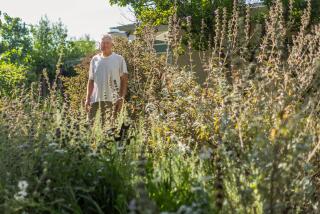Nutgrass: Three experts’ solutions to one of the worst weeds
- Share via
Dear SoCal Garden Clinic,
My garden, as well as many of my neighbors’, is overrun by nutgrass. I have tried the product recommended by a local garden store, with not good results. It is expensive, and I tried it two times, but the nutgrass grew back with a vengeance. I also tried digging up the weed, including the roots, but again it grew back. What more can I do? This seems to be a problem in many neighborhoods, especially in the San Gabriel Valley.
Mary Ann Ramirez
Temple City
Before we get to our expert answers, some clarification on what nutgrass actually is. Nutgrass is the common term for what a weed expert said is technically nutsedge.
“In California we have yellow nutsedge (Cyperus esculentus) and purple nutsedge (Cyperus rotundus),” said Cheryl Wilen, area integrated pest management advisor for the University of California’s pest management program. “It is hard for the untrained eye to tell the difference.”
Wilen differentiates the two by looking at the plants’ underground tubers: Purple nutsedge tubers have a lot of fibers on the outside, and yellow nutsedge tubers are smoother. “If you are inclined to bite into one,” she said, “yellow nutsedge has a pleasant almond or brazilnut taste, while purple nutsedge does not have a good flavor.” Another difference: Yellow nutsedge has straw-to-light brown flower head, and purple nutsedge has a dark brown-to-purple flower head.
The controls for both is largely the same. Because strategies for fighting weeds prompt such vigorous discussions, we turned to not one but three of our SoCal Garden Clinic panelists for their recommendations.
First up: Yvonne Savio, manager of the UC Cooperative Extension’s Common Ground Garden Program for Los Angeles County. She oversees the training of master gardeners. Savio writes:
The weeds most commonly called “nutgrass” are among the most hated by gardeners. You don’t want these to even begin to get established in your garden. Even the big-guns approach -- using Round-Up -- frequently isn’t successful.
The crux of the problem are the “nuts” that grow underground. Unless you remove all of those little nut-like formations -- especially the teeny tiny babies -- they will mature underground and resprout aboveground. By the time you see the foliage of new shoots, the nuts have proliferated below ground.
The only way I’ve found to remove any remnants is to dig 6 inches around and under each weed and discard it. Don’t even think of composting the weed or filtering the soil through a screen. Those almost-invisible baby nutlets will start the process all over again, and they could spread through the compost. You’ll waste soil but gain peace of mind that you’ll have no more nutgrass within your garden realm.
Frank McDonough, botanist at the Los Angeles County Arboretum and Botanic Garden in Arcadia:
Because we don’t use chemical controls, the only method we have at our disposal is removal. The most effective control of nutgrass that has established itself in the ground is to remove the soil down to 18 inches and replace it with nutgrass-free soil.
The other strategy is détente: We have a very lovely lawn in an area that, upon inspection, consists mostly of nutsedge.
Alan Uchida, third-generation nurseryman at Bellefontaine Nursery in Pasadena:
This is one case when you must give in to chemicals. No matter how much smothering, sifting and digging out you do, the weed will return without use of an herbicide.
Bonide Sedge Ender is an effective control of nutgrass and sedges. It kills nutgrass and prevents it from coming back. A new product from Monterey is Nutgrass Killer Selective Herbicide, which can be used in established lawns or around woody ornamentals.
Sometimes people find these kinds of products do not work as effectively as hoped. I find that some herbicides need to be applied more than once or twice, depending on weather conditions and severity of the infestation.
Applying herbicides with small hand sprayers will minimize overspraying. Make close contact to kill the targeted weed. The smaller and younger the weed, the easier to kill.
Questions for our garden clinic — plant health emergencies, plant selection conundrums, design quandaries — can be sent to home@latimes.com. Please put “SoCal Garden Clinic” in the subject line. Include a photo if you’d like. Because of the volume of mail we receive, we cannot respond to all questions.
You can find L.A. at Home on Facebook, Twitter and Pinterest.






